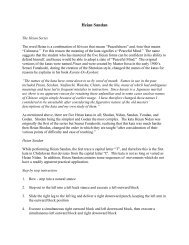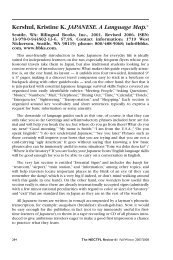selected paintings - Dickinson College
selected paintings - Dickinson College
selected paintings - Dickinson College
Create successful ePaper yourself
Turn your PDF publications into a flip-book with our unique Google optimized e-Paper software.
19<br />
Haystacks, Giverny, n.d.<br />
Oil on canvas, 23 1/2 x 28 1/2 in. (59.7 x 72.4 cm)<br />
Signed: l.r.: Quincy<br />
Exhibited: Spirit of the Past: The Paintings of Edmund Quincy, 1903-1997 (New<br />
York: Hirschl & Adler Galleries, 2000).<br />
Published: Zachary D. Ross, Spirit of the Past: The Paintings of Edmund Quincy,<br />
1903-1997 exh. cat. (New York: Hirschl & Adler Galleries, 2000), 24,<br />
38, cat. 52.<br />
Courtesy of Hirschl & Adler Galleries, NYC<br />
Edmund Quincy constantly traveled back and forth to Europe<br />
throughout his career. He spent the majority of his time studying<br />
in Paris during his early years as an artist where his style<br />
began to develop. In the late 1920s, Quincy began to show his<br />
<strong>paintings</strong> in group exhibitions and then in 1930, he exhibited<br />
his <strong>paintings</strong> in his first one-man show at Galerie d’Art<br />
Contemporian in Paris. 1 Quincy’s exhibition was widely<br />
acclaimed and helped launch his career. 2 Quincy continued to<br />
exhibit his American and European <strong>paintings</strong> in Paris all the<br />
way through the 1950s. 3<br />
Quincy’s Haystacks, Giverny depicts the popular and frequently<br />
painted countryside of Giverny in northern France,<br />
made famous by Monet’s series of haystack <strong>paintings</strong> completed<br />
in the late 1880s. Despite the frequent portrayals of this site,<br />
Quincy’s painting is a unique rendition of Giverny because it<br />
presents the landscape the way that he wanted to see it. The<br />
painting’s saturated color palette, warm highlights, and natural<br />
elements, untouched by manmade structures and figures, create<br />
a harmonious, idyllic atmosphere that celebrates the charm and<br />
beauty of this popular location. Quincy has captured the<br />
essence of Giverny, and he presents a scene that is unique to this<br />
particular place as well as to his own experience of it.<br />
Haystacks, Giverny has a texture and style that resemble the<br />
works of Impressionists, such as those by Monet that also represent<br />
the haystacks and landscape of Giverny. Quincy’s focus on<br />
light and shadow, both of which contain a soft violet hue, is<br />
reminiscent of many Impressionist depictions of light. His visible<br />
brushwork layers colors with small paint strokes, adding dimension<br />
to the image. These obvious layers of careful over-painting<br />
show that Haystacks, Giverny was not completed as an “impression”<br />
on sight, but rather the shifting light and motion in the<br />
brushwork create a painting that compels the viewer to recall<br />
the <strong>paintings</strong> of the Impressionist movement.<br />
There is an obvious connection to Monet in the subject<br />
matter of this painting. Monet also painted a series of haystacks<br />
in Giverny in different light, weather conditions, and times of<br />
day during the late 1880s. Like Monet, Quincy utilized an<br />
“impressionist” palette. Various shades of violet dominate the<br />
shadows in both Monet’s and Quincy’s works. Rough brushstrokes<br />
reveal numerous different colors in every centimeter of<br />
the <strong>paintings</strong>. However, Quincy’s haystacks differ from Monet’s<br />
in their compositional layout. Monet’s haystacks were depicted<br />
50<br />
with very little detail in the background. Quincy incorporates<br />
the haystacks as an aspect of his landscape in the composition,<br />
along with the changing colors of the grass, the verticality of the<br />
trees, and the curvilinear shapes of the hills.<br />
Quincy did not include humans or architecture in<br />
Haystacks, Giverny and therefore, it is his purest landscape.<br />
Quincy captured the vast landscape of agriculture within the<br />
scene where the rolling hills and the patterned fields enhance<br />
the environment. Natural color and design evoke an unrefined<br />
atmosphere of crisp agriculture. The essence of nature is represented<br />
in the simplicity and elegance of the landscape. Small,<br />
quaint haystacks draw the viewer into the foreground, which<br />
then lead him or her over the rolling hills and into the background.<br />
The complexity and structure of architecture and people<br />
are not needed within this landscape; the simple pattern of<br />
nature is enough to evoke a viewer’s interest.<br />
The range of tonality in most of Quincy’s works, and<br />
specifically in Haystacks, Giverny and The Garden Wall, illustrates<br />
both depth and perspective. The loose application of paint<br />
in these works creates the visual effect of luminosity in the leaves<br />
of the trees and ground. Quincy also used light to create depth<br />
in both <strong>paintings</strong>, which is important to the sense of movement<br />
in both. These landscapes have manmade elements, which are<br />
distinguished from the fluidity of their natural surroundings.<br />
While the manmade elements are fixed in Quincy’s The Garden<br />
Wall, the manmade elements in Haystacks, Giverny are suggested<br />
only by the baling of the haystacks.<br />
Quincy created an atmosphere in this painting that surrounds<br />
the spectator. Instead of focusing on a single haystack,<br />
Quincy depicted not only the haystacks themselves, but also the<br />
environment around them. Therefore, the trees and fields<br />
around the haystacks provide a location with which the viewer<br />
can relate to the haystacks. The viewer is placed within the environment<br />
at the bottom of the hill, taking the place of Quincy as<br />
he made the painting. This placement allows for the spectator<br />
to be located where a haystack may have been standing. The<br />
spectator is therefore able to perceive the essence of the location<br />
and take the place of the painter within the composition.<br />
Quincy was able to portray a particular moment in time in<br />
his painting. He conveys the time of day (most likely afternoon),<br />
through the intensity of the light and the long, dark<br />
shadows cast by the haystacks. He also shows the season in<br />
which the scene takes place since hay is gathered at a certain<br />
time of year, after the flush of the farming season. More subtly,<br />
Quincy created a sense of movement in his painting. The clouds<br />
look as if they are rolling through the sky, being pushed by the<br />
wind—a wind that is perhaps blowing with the change of seasons<br />
and suggesting that this scene is only temporary. Haystacks,<br />
Giverny epitomizes Quincy’s unique vision, and that of the<br />
viewer, in depicting the temporality and character of his subject.






